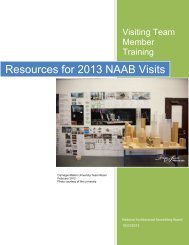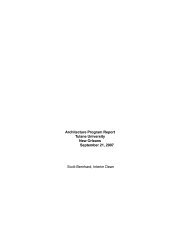NAAB Architecture Program Report (APR) 2013 - Tulane School of ...
NAAB Architecture Program Report (APR) 2013 - Tulane School of ...
NAAB Architecture Program Report (APR) 2013 - Tulane School of ...
You also want an ePaper? Increase the reach of your titles
YUMPU automatically turns print PDFs into web optimized ePapers that Google loves.
<strong>Tulane</strong> University<strong>Architecture</strong> <strong>Program</strong> <strong>Report</strong>September <strong>2013</strong>Instructional & Research Resources: The adequacy and relevance <strong>of</strong> library/learning resources tosupport <strong>Tulane</strong>’s educational, research and service needs is determined through the library’s annualevaluation <strong>of</strong> multiple data compiled for the comparative Association <strong>of</strong> Research Libraries Statisticprogram, from faculty feedback obtained through the library’s liaison program, from periodic usersurveys, from assessment <strong>of</strong> library instructional <strong>of</strong>ferings, and from the library’s regular self-review <strong>of</strong>library policies, guidelines and documentation.The first floor <strong>of</strong> Howard-Tilton Memorial Library features a new prototype Learning Commons that hasquickly become the building’s most prominent space, designed as a dynamic environment thatpromotes collaborative teaching, research and learning. The Learning Commons is the primary place tointeract one-on-one with research librarians, technology experts, media specialists and library staffworking out <strong>of</strong> a central service point. The Commons features individual and group work areas,comfortable seating in mutable configurations, iMacs and PCs equipped with an array <strong>of</strong> s<strong>of</strong>tware,including productivity apps and media production tools. Laptop visitors benefit from high-speed 802.11nwireless network access, convenient access to utilities and ergonomic workstations.The Library Instruction <strong>Program</strong> at Howard-Tilton Memorial Library’s Center for Library User Education(CLUE) assists students in developing skills and abilities that enable them to find, access, evaluate anduse information sources within and beyond their academic studies. Using the Information LiteracyCompetency Standards for Higher Education as a framework, CLUE librarians collaborate with facultyto integrate information literacy skills into the curriculum by creating online guides and tutorials,teaching course- and database-related workshops, and providing individualized research consultationsand virtual reference interactions.The <strong>Architecture</strong> Library provides an optimal setting for quiet study and research in the <strong>School</strong> <strong>of</strong><strong>Architecture</strong>. Parapr<strong>of</strong>essional library staff respond to faculty and student requests for instructional andresearch resources, including interlibrary loan and <strong>of</strong>fsite materials requests, scanning andphotocopying services, and managing faculty course reserves. The branch library is equipped withlarge format book-edge scanners, photocopying and digital camera equipment. Public computerterminals provide access to <strong>Tulane</strong> libraries’ online catalog, subscription databases, e-journals and theInternet. Laptop visitors benefit from high-speed 802.11n wireless network access.Special Collections departments including the Southeastern Architectural Archive (SEAA) provideindividual and course-based instruction emphasizing the use <strong>of</strong> primary documents. <strong>Architecture</strong> andpreservation studies courses frequently meet in the SEAA to analyze cartographic techniques,architectural and illustrative practices, and historically significant places as documented in buildingplans, site surveys, historic photographs and/or artifacts. The SEAA also promotes object-basedinstruction and research by providing individualized consultations with faculty and students, and bydeveloping online resources and annual exhibitions that contextualize primary documents associatedwith the built environment.Collaborations & Regional ResourcesCooperative Borrowing <strong>Program</strong>s:<strong>Tulane</strong> faculty, staff and students benefit from numerous cooperative borrowing programs that greatlyexpand access to scholarly resources. Howard-Tilton Memorial Library is a member <strong>of</strong> the Center forResearch Libraries (CRL), an international consortium <strong>of</strong> university, college and independent researchlibraries. <strong>Tulane</strong>’s membership affords its faculty and students unlimited access to a collection <strong>of</strong> morethan 5 million items, extended interlibrary loan and digitized content. CRL holdings include historicnewspapers and fire insurance atlases, as well as pamphlets, brochures and monographs associatedwith architectural history and design.Additionally, the library participates in several regional cooperative or reciprocal borrowing programs:51














